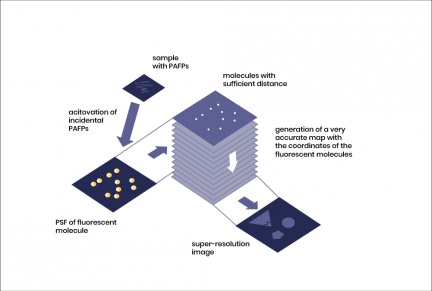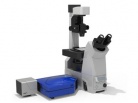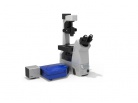PALM (PhotoActivation Localization Microscopy), or photoactivation localization microscopy, is a localization microscopy method used for super-resolution imaging of objects stained with fluorescent probes. The principle of PALM is based on the precise localization of individual fluorescent photoactivatable molecules (usually proteins, so-called PAFPs = photoactivatable fluorescence proteins) leading to image reconstruction. These molecules emit a large number of photons depending on the wavelength and intensity of the excitation radiation, and are able to change their emission state by switching off or changing colour (fluorescence) as the wavelength changes. Imaging fluorescent molecules individually in a random selection based on fluorescence activation is possible if the following condition is met:
The fluorescing molecules must be spaced farther apart than the conventional resolution of the objective - that is, only one molecule out of tens to hundreds of molecules within a circle with a radius corresponding to the conventional resolution of the microscope is allowed to fluoresce at any given time. To achieve super-resolution, it is therefore necessary to ensure that two nearby molecules with overlapping PSFs(Point Spread Function) are not imaged simultaneously.
By fulfilling this condition, a sequential localization of all molecules present in the fluorescent probe is possible after several thousands to tens of thousands of repetitions.
Activation of only a limited number of molecules from the total number of potential fluorescence sources is ensured by switching the PAFPs to the fluorescent state using low-intensity light pulses. The switched PAFPs are then imaged under simultaneous excitation in the PSF integration mode until their fluorescence is lost due to photobleaching. The degraded molecules are no longer used in further photoactivation processes, thus facilitating the localization of further fluorescent probe molecules until a very accurate map of fluorescent objects is produced, which represents a super-resolution image of the spatial distribution of all probe molecules in the sample.



